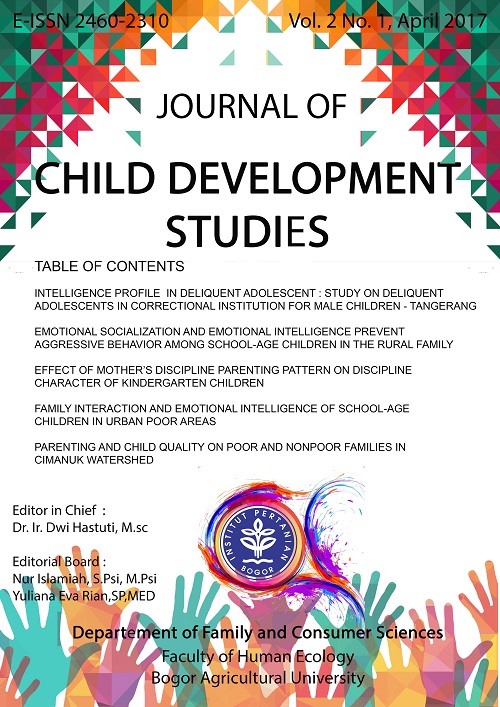Intelligence Profile in Deliquent Adolescent (Study on Deliquent Adolescents in Correctional Institution for Male Children- Tangerang)
Abstract
Violence perpetrated by adolescents is very related with youth psychological conditions, one of which is intelligence aspect. Intelligence is an individual potency to be able to resolve problems logically, directed, and using ways that can be accepted by the environment. Through this study, we want to get the profile of the intelligence of juvenile perpetrators of violence who are now in correctional institution. The benefit of this study is to give an informations for parents and teachers to provide an appropriate parenting and education. This is a qualitatively study from four adolescent participants who commited violent crimes, aged 15-18 years, and they are residents of correctional institution for male children in Tangerang. Participants Intelligence was evaluated using Wechsler Intelligence Scale for Children (WISC) or Wechsler Belleveu (WB), and followed with interview of all participants. The study was conducted in February 2013 to May 2013. The Results show the full IQ scores of participants were in the category of Borderline Intellectual Functioning, with performance skills grew significantly than verbal skills. The Additional data about the participants was the participants were grew up in the families, which the parenting style of the parents or signficant persons accompanied by violence.
Downloads
References
Arsenio, W. F., E. Adams, & J. Gold. (2009). Social information processing, moral reasoning and emotion attributions: Relations with adolescents’ reactive and proactive aggression. Child Development, 80(6), 1739–1755.
Berns, R.M. (2007). Child, family, school, community socialization and support (7 th ed.). California: Thomson Wadsworth.
Badan Pusat Statistik Indonesia. (2010). Profil Kriminalitas Remaja 2010. Jakarta: Katalog BPS.
Brennan, P. A., J. Hall, W. Bor, J. M. Najman, & G. Williams. (2003). Integrating biological and social processes in relation to early-onset persistent aggression in boys and girls. Developmental Psychology, 39, 309 - 323.
Brugman, S., J. Lobbestael, A. Arntz, M. Cima, T. Schuhmann, F. Dambacher, & A.T. Sack. (2014). Identifying Cognitive Predictors of Reactive and Proactive Aggression. Aggressive Behavior. Volume 9999, pages 1–14.
Castro, B. O. (2004). The Development of social information processing and aggressive behavior: current issues. European Journal of Developmental Psychology, 1, 87-102
Guay, J.P., M. Ouimet, & J. Proulx. (2005). On intelligence and crime: A comparison of incarcerated sex offenders and serious non-sexual violent criminals. International Journal of Law and Psychiatry, vol. 28. Elsevier Inc. All rights reserved. doi: 10.1016 / j.ijlp.2004.03.010
Huesmann, L.R., L.D. Eron, & P.W. Yarmel. (1987). Intellectual Functioning and Aggression. Journal of Personality and Social Psychology, APA. Vol. 52.No.l, 232-240
Ijaz, S., S.F. Kazmi, & F. Nazir. (2013). Culture As A Factor Of Intelligence Among Secondary Level Students. IOSR Journal of Research & Method in Education (IOSR-JRME) 1 (4), 40-45.
Latzman, R.D. (2009). Interrelation Among youth temperament, executive function, and externalizing behaviors. Dissertation at Iowa Research Online: http: //ir.uiowa/etd/306.
Liu, J. (2011). Early Health Risk Factors for Violence: Conceptualization, Review of the Evidence, and Implications. Aggress Violent Behav.; 16(1): 63–73. doi:10.1016/j.avb.2010.12.003.
Moffitt, T.E., W.F. Gabrielli, S.A. Mednick, & F. Schulsinger. (1981). Socioeconomic status, IQ, and delinquency. In: Mottus, R., J. Guljajev, J. Allik, K. Laidra, & H. Pullmann. 2011. Longitudinal associations of cognitive ability, personality traits and school grades with antisocial behavior. European Journal of Personality, 26 (1), 56-62. DOI: 10.1002 / per.820
Moshkani, M., G.A. Afrooz, & A.A. Arjmandnia. (2015). Analytical comparison of general intelligence, verbal and practical capacities, Reviews their subscales and academic achievement of delinquent and non-delinquent youth. GMP Review, 16 (3), 317-324.
Murtiyani, N. (2011). Hubungan Pola Asuh Orang Tua dengan Kenakalan Remaja di RW V Kelurahan Sidokare Kecamatann Sidoarjo. Jurnal Keperawatan, 01(01), 1-9.
Moshkani, M., G.A. Afrooz, & A.A. Arjmandnia. (2015). Prediction of factors Affect deliquent behavior in deliquent and non-deliquent Adolescents. Indian Journal of Fundamental and Applied Life Sciences, 5 (1), 317-324. Retrieved 16 September 2015, from www.cibtech.org/sp.ed/jls/ 2015/01 / jls.htm 2015 Vol.5 (S1), pp. 5115-5124 / Moshkani et al.
Ogdon, D.P. (1996). Psychodiagnostics and Personality Assessment: A Handbook (2 nd ed.) WPS USA.
Raine, A., K. Dodge, R. Loeber, L. Gatzke-Kopp, D. Lynam, C. Reynolds, M. Stouthamer-Loeber, & J. Liu. (2006). The Reactive–Proactive Aggression Questionnaire: Differential Correlates of Reactive and Proactive Aggression in Adolescent Boys. Aggress Behav. April 1; 32(2): 159–171. doi:10.1002/ab.20115.
Salekin, R.T. & P.J. Frick. (2005). Psychopathy in Children and Adolescents: The need for a developmental perspective. Journal of Abnormal Child Psychology, vol. 33 no. 4. DOI: 10.1007 / s10802-005-5722-2.
Sattler, J.M. (2001). Assessment of children: cognitive application (4 rd ed.). San Diego: Jerome M. Sattler Publisher, inc.
Stickle, T. R., N.M. Kirkpatrick, & L.N. Bursh. (2009). Callous-unemotional traits and social information processing: Multiple risk-factor models for understanding aggressive behavioral in antisocial youth. Law and Human Behavior, 33, 515–529.
Wechsler, D. (1958). The measurement and appraisal of adult intelligence. In: Sattler, J.M. 2001. Assessment of children: cognitive application, 4 rd ed (p.136). San Diego: Jerome M. Sattler Publisher, inc.
Wyhe, K. (2012). Wechsler Abbreviated Scale of Intelligence: Preliminary normative data for 12-15-year-old English- and Afrikaans-speaking Coloured learners in the Western Cape. Dissertation. Published by the University of Cape Town (UCT). https://open.uct.ac.za/bitstream/item/12279/thesis_hum_2012_van_wyhe_k.pdf?...1
Sujoko. (2011). Hubungan antara keluarga broken home, pola asuh orang tua dan interaksi teman sebaya dengan kenakalan remaja. Thesis, Universitas Muhammadiyah Surakarta. http://eprints.ums.ac.id/13181/

